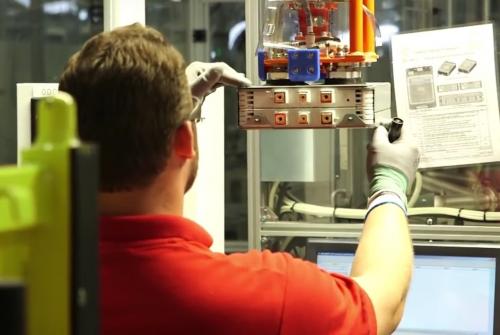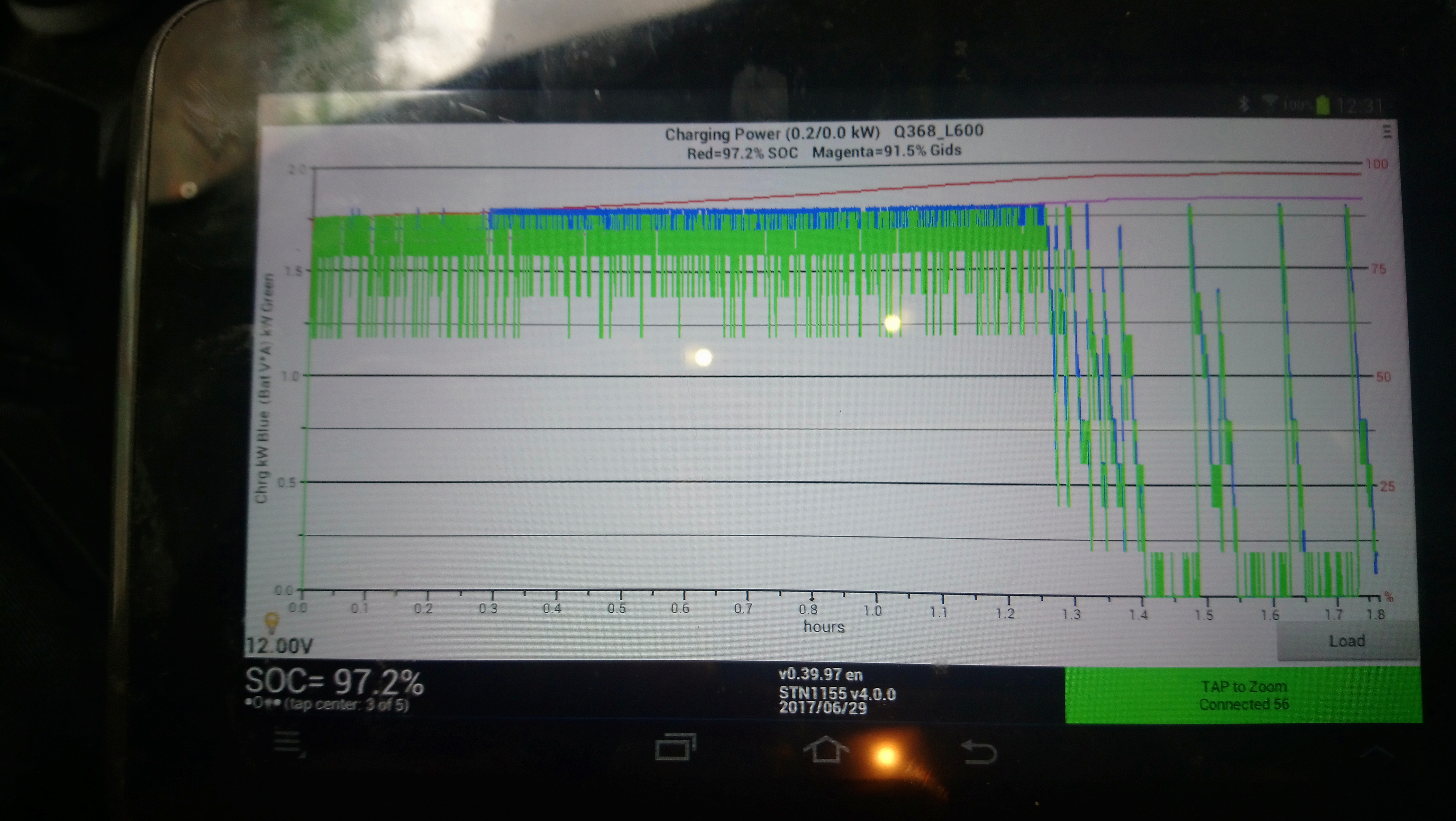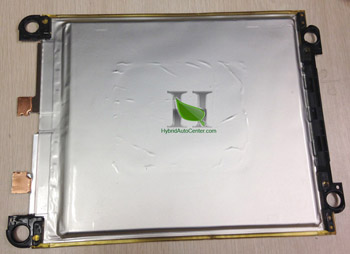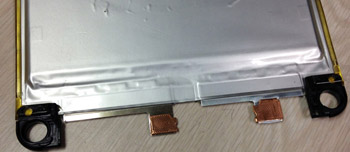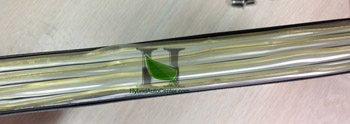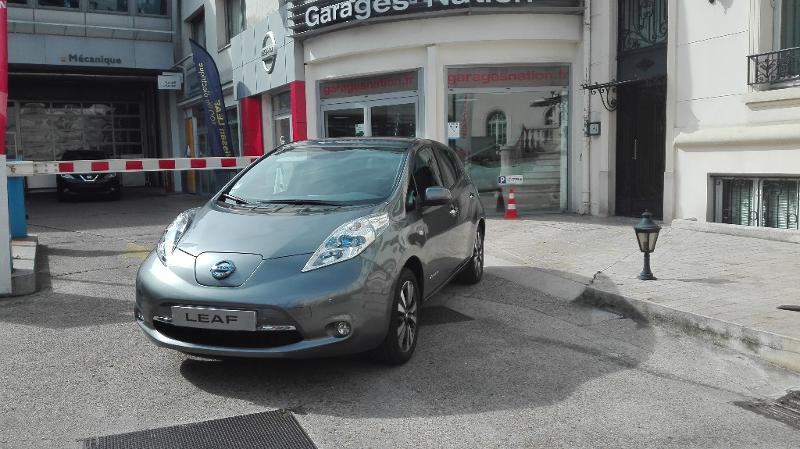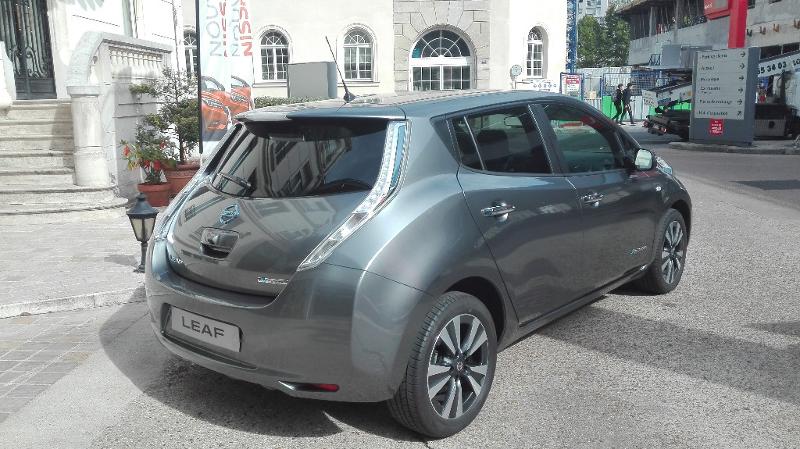- Részletek
- Írta: Molnár Norbert
- Kategória: Akku
- Találatok: 390
https://www.youtube.com/watch?v=YV3Qgd01-h8
képek a videóból:
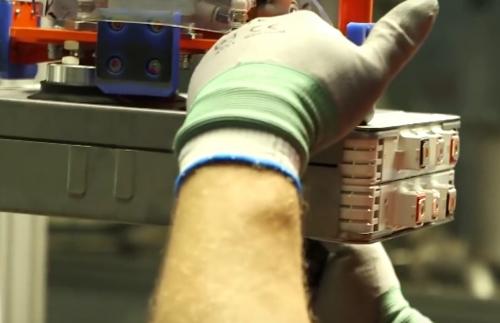
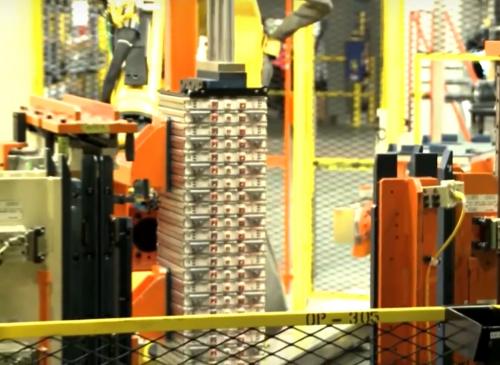
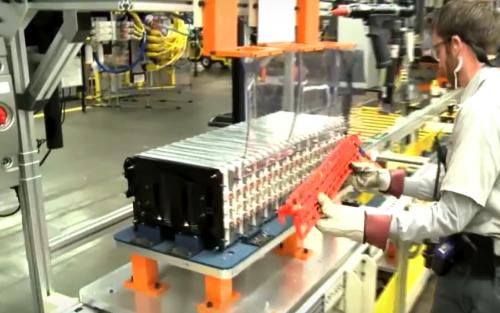
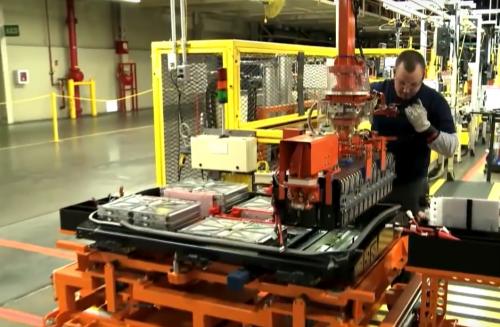
Bontott pakk:
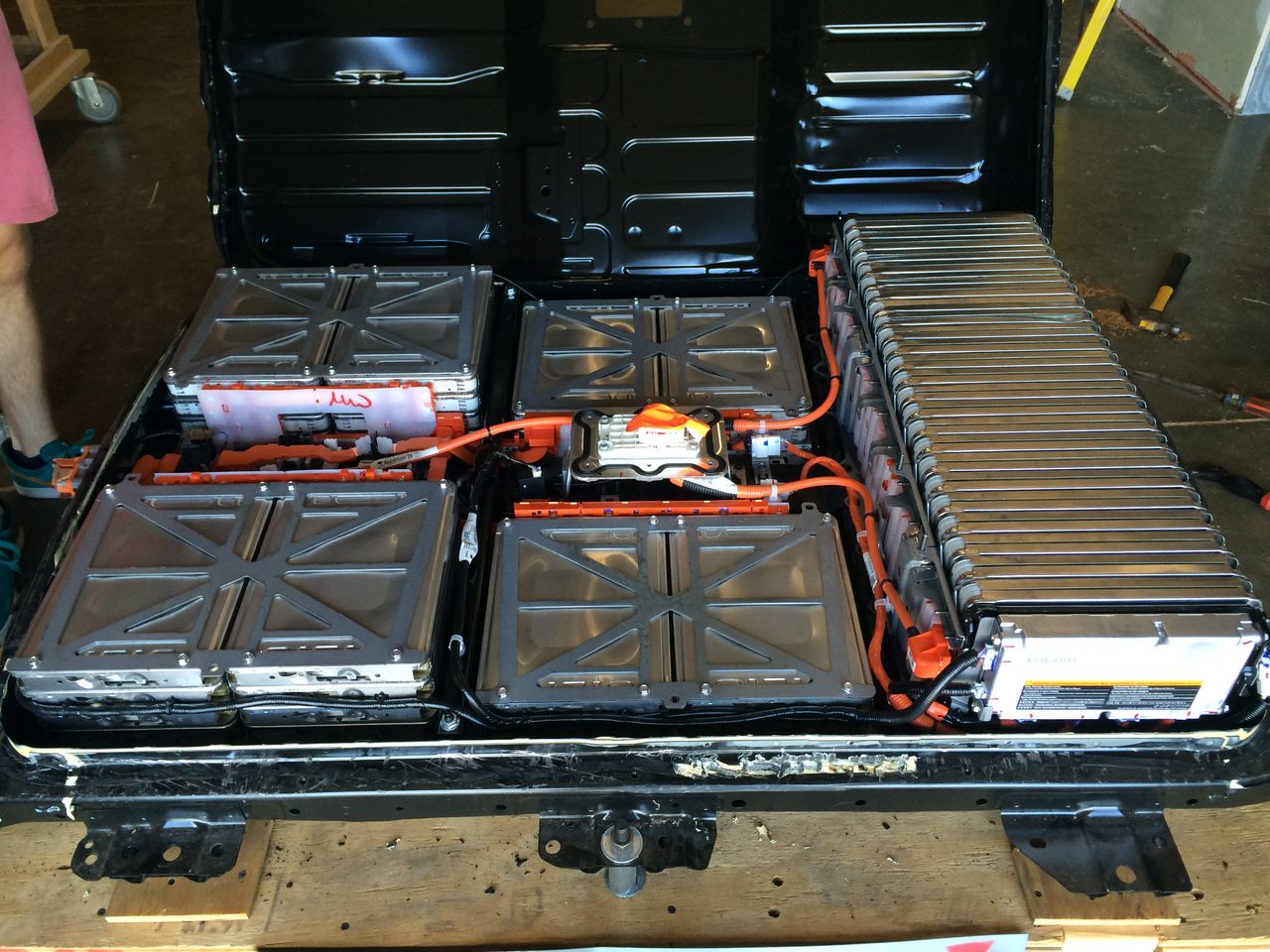
- Részletek
- Írta: Molnár Norbert
- Kategória: Akku
- Találatok: 441
A 30kWh pakkban 24modul van sorban, 1 modul 8 cellából áll (24kWh-ban 48 modul, modulonként 4 cella.)
Névleges feszültség ugyanaz.
82Ah 1250Wh Lithium Li-Ion Golf Cart Pack Battery Module EV NISSAN Leaf
LITHIUM BATTERY PACK LiMn2O4/LiNiO2
82Ah, 8 CELLS 3.7V each, Maximum 4.2V per cell. (2S2P + 2S2P)
Total 16.8V maximum
Rated 1250Wh
Contains 4 cells 82Ah
Size of the pack - , weight 18.7lb
MODULE SPECIFICATIONS
Number of cells 8
Construction 2S2P + 2S2P
Length 11.9291" (303 mm)
Width 8.7795" (223 mm)
Thickness 2.6" (70 mm)
Weight 18.7 lbs (8.5 kgs)
Output terminal M6 nut
Voltage sensing terminal M4 nut
Module fixing hole diameter 0.3582" (9.1 mm)
CELL SPECIFICATIONS
Cell type Laminate type
Cathode material LiMn2O4 with LiNiO2
Anode material Graphite
Rated capacity (0.3C) 41 Ah
Average voltage 3.7 V
Length 11.417" (290 mm)
Width 8.504" (216 mm)
Thickness 0.2795" (7.1mm)
Weight 1.7624 lbs (799 g)
375USD
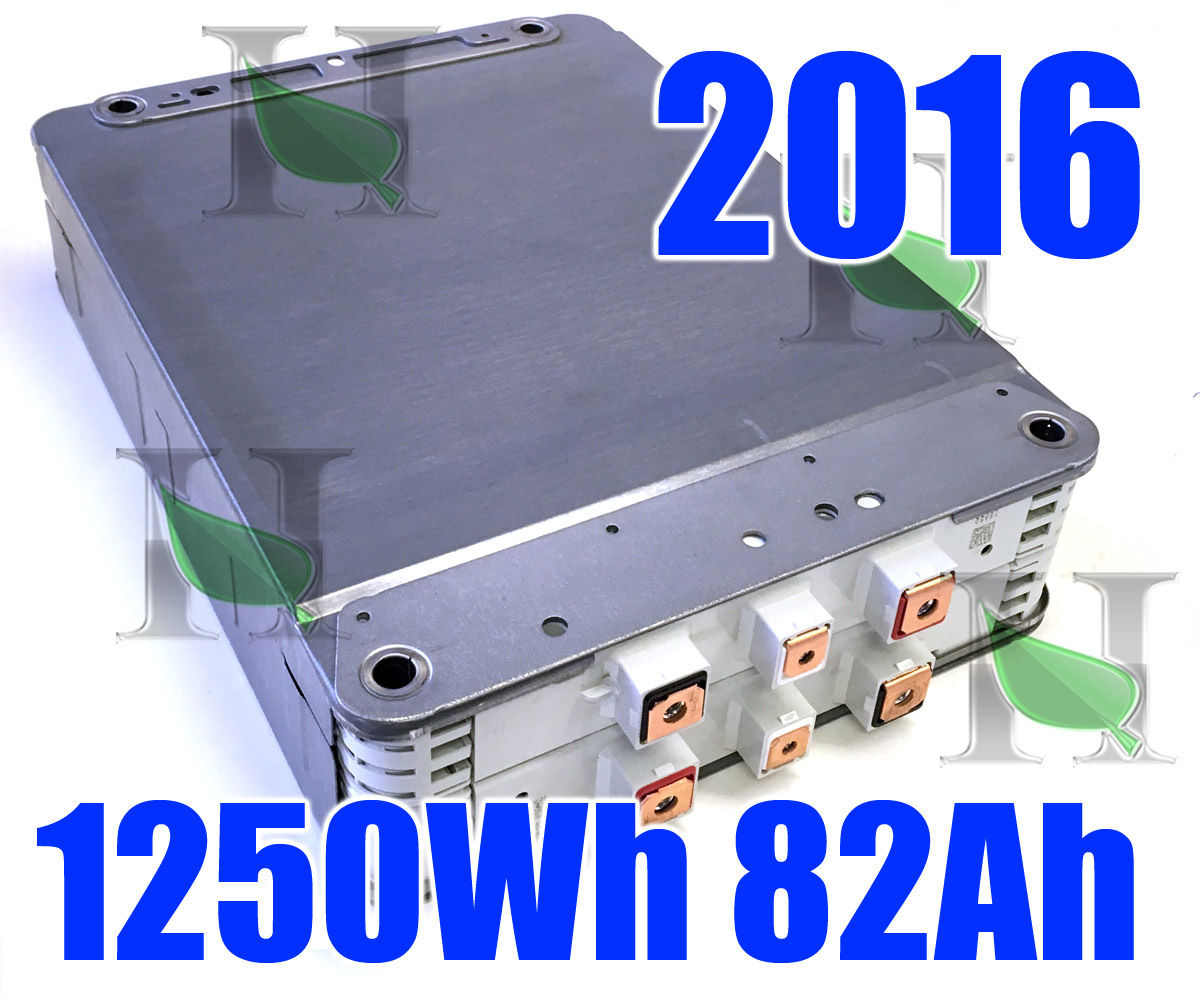
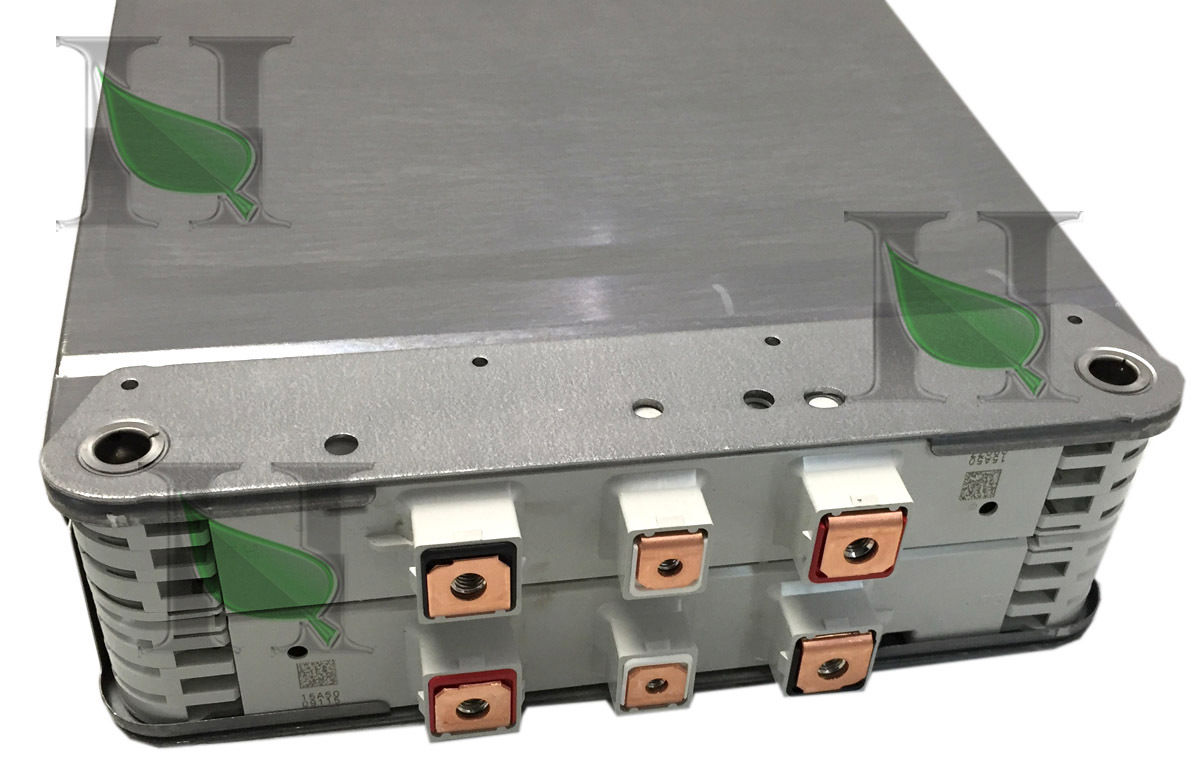
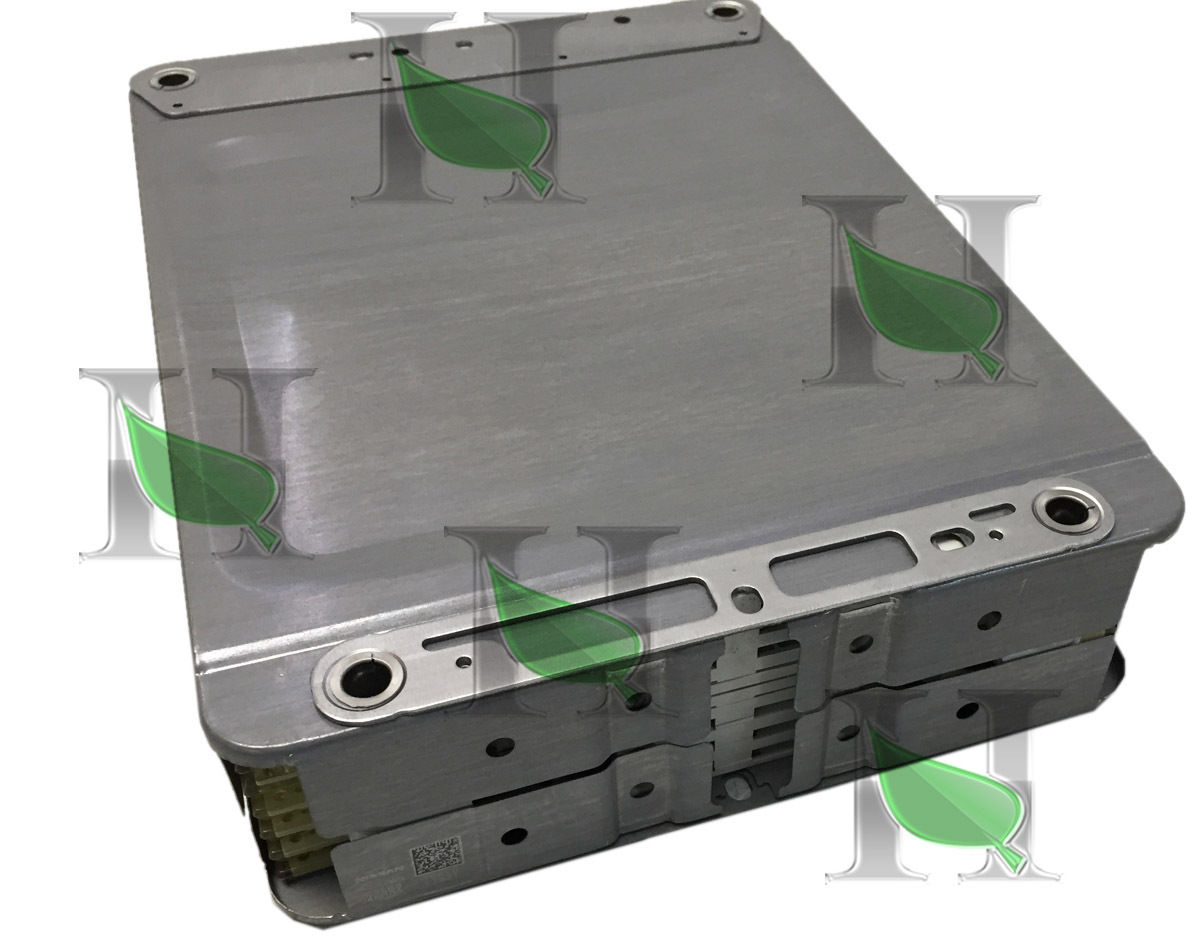
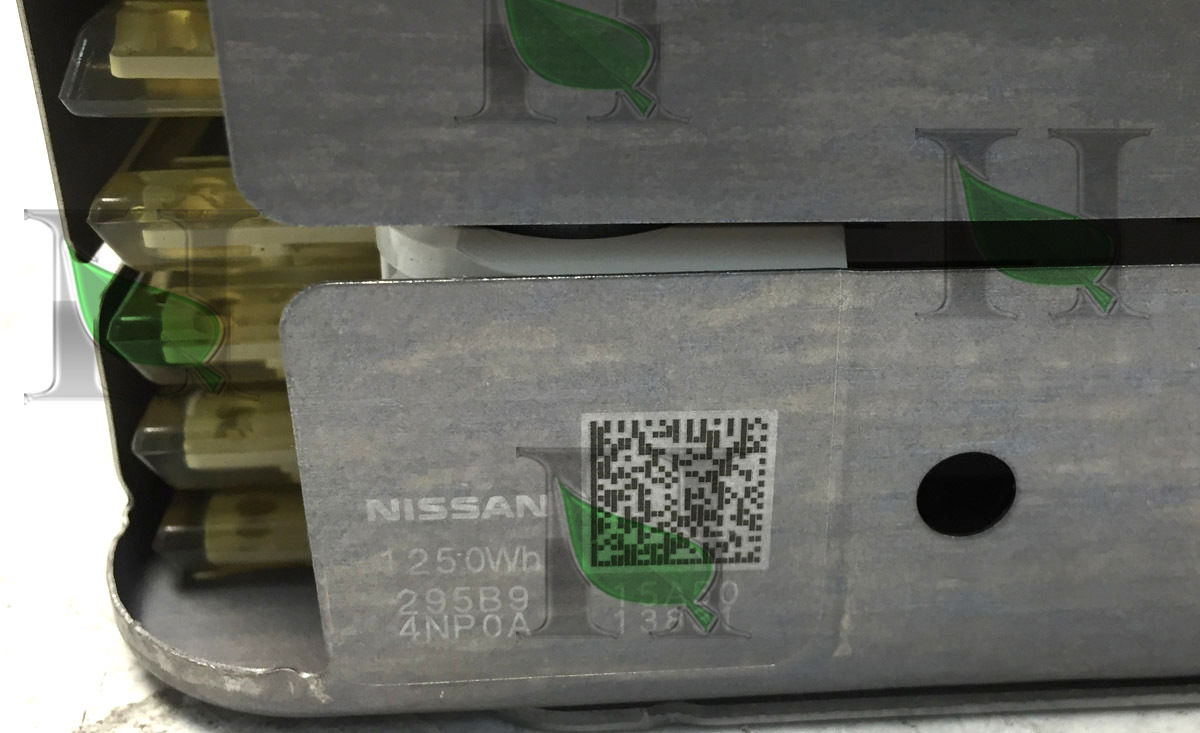
Hybridcars
Other batteries in stock:
2016 modules - 82Ah (4 cells) - $338
2016 modules - 66Ah - $139
2013-14 modules - 60-64Ah - $118-$132
2013-14 modules - 52Ah - $85
Contact us for prices and custom configurations 866-516-5066
Also available VOLT 2017, NISSAN LEAF 2016, TESLA 2016, Mercedes 2016 BATTERIES
Price - $180-$280 per kWh
- Részletek
- Írta: Molnár Norbert
- Kategória: Akku
- Találatok: 460
30kWh nem jó 24kWh helyére.
Eltér belül is, cellák kötése más.
While both the new 30 kWh pack and old 24 kWh pack have contain 192 individual cells for a total nominal battery voltage of 360 volts, the old pack is made up of a string of forty-eight modules, each containing four cells per module. The new 30 kWh pack contains twenty-four modules, each containing eight cells per module.
While that gives the same nominal voltage as the old pack, we’d guess the way in which the on-board battery management system manages and monitors individual cells and modules is different, meaning that a new power management unit is required for the 30 kWh battery pack.
For new vehicles rolling off the production line, that change is fairly simple to make. But in order to use the 30 kWh pack in an older Nissan LEAF that originally shipped with a 24 kWh pack, we’d guess multiple components in addition to the battery pack would need to be replaced.
That would be a costly and somewhat complex process.
- Részletek
- Írta: Molnár Norbert
- Kategória: Akku
- Találatok: 483
battery is a chemical sandwich. Degradation happens because battery is not 100% stable and some processes are not reversible.
To stop degradation chemical processes must stop happening. At absolute zero degradation stops. But there is a critical
temperature where chemistry inside Li-ion cells will freeze. Let's assume that lowest healthy temperature is 1 temperature bar.
Chemistry inside cells is not frozen. Chemical processes happen but are very slow. This is why at some point charging speed
is limited and at another even acceleration is limited. This all boils down to voltage at every cell terminals: if chemistry is cold
adding charge results in voltage to rise to maximum (4.13V for Leaf) very rapidly because the "surface" of chemistry is saturated
with fresh juice but getting deeper takes a lot of time. Same with acceleration: pushing go pedal will result the whole pack to
suck juice at maximum speed. Surfaces of every cell are stressed with discharge. Voltage drops. To get the same power (80kW)
more amps must be pushed. But there is a limit. This is why acceleration will be limited at some point. This heavy pushing of
juice has some stress on the cells. Some of that pushing turns into defects. Eventually we call it degradation.
It is OK to charge/discharge at low temperatures but the rate of should be limited (unfortunately discharge is not).
At moderate temperatures chemical processes happen faster. Charging and discharging can happen faster as juice inside every
cell can move faster. Heavy discharging/charging is more healthy for the cell at appropriate temperatures because the whole cell
share the load more or less evenly. Unfortunately at moderate temperatures processes that are not needed also happen.
With higher and higher temperatures charging and discharging can happen faster and faster but vehicle can't use that
power anyway. Unfortunately unwanted processes happen more rapidly at that state without any advantages.
To sum up TEMPERATURE: the lower the temperature the slower the degradation. The lower the temperature the less capable
the battery is.
Defects also happen when juice is pumped in or out of the cell. This is hard to avoid. But what can be avoided are
the extremes: very full and very empty. Ideally cycles near 50% of charge are very easy to chemistry: there is a
good tendency for juice to complete the trip without defects to either side: cathode and anode (charging or discharging).
Also what can be avoided is pushing hard near the limits: rapid charging when very full (luckily Leaf has excellent
control over it as it never ever let any cell exceed maximum defined voltage) and rapid discharging while nearly empty.
Unfortunately Leaf has very bad control over that. Many users might have noticed that full power is available up
to the point when Leaf is almost dead. Then the Turtle appears. Power is heavily limited to very safe levels. I have analyzed
the situation and I can tell that when there is less than 10% of charge any heavy acceleration heavily pushes the whole
pack. Voltage is very unstable (the surfaces of cells are stressed). Some cells show more strength and some are weaker.
As I don't have a degree in chemistry I can not tell for sure is that harmful or not but I strongly suggest not to push Leaf
when low battery warning has appeared. For example Tesla's start to limit discharge rate much sooner than Leaf.
To sum up STATE OF CHARGE: using state of charge between 80% and 30% has acceptable effects on degradation.
The closer to extremes multiplied with temperature the faster defects occur. It means that the worst thing to do is
to fully deplete the battery and keep it hot. The second worst thing is to fully charge the battery and keep it hot.
The speed of charging would be noticeable harmful if the voltage for any cell would get higher than magical 4.13V.
But it doesn't. So if we subtract degradation that happens with temperature and subtract degradation that happens
with maximum charge state 4.13V at recommended temperatures (which is not much really) there is hardly any more
defects that happen when rapid charging. Unfortunately really fast charging (30kW-50kW) only happens when cell is
not slow (not cold). This means ideal temperature or hotter. If it is ideal temperature it will soon be above that.
If it is above ideal temperature it will soon be way above ideal temperature. And this is why eventually heavy use of
Leaf's battery (taxi driving for example) with no way to cool chemistry faster will result in more degradation than on average.
It is true that charging up to 80% at moderate speed (up to 6,6kW for Leafs) does indeed have slightly less degradation
than rapid charging up to 80%. This is because the safe upper limit 4.13V is not reached even while charging (up to 1 hour).
The day when battery was manufactured does not have any direct relations with life left. At ideal storing conditions
battery that is a decade old can be in better shape than a battery that has been used for one summer.
As we mostly don't keep our vehicles is freezers degradation does happen. So the philosophy is simple:
use it but don't abuse it. Keeping car below 25C / 80F (24h average) and at 80% charge is reasonable for
excellent lifetime.
http://mynissanleaf.com/viewtopic.php?f=9&t=20912
- Részletek
- Írta: Molnár Norbert
- Kategória: Akku
- Találatok: 379
Érdekes tanulmány, az USA egyik nemzeti laborjából, meglehetősen nagy távolság alatt begyűjtött mérési adatokra támaszkodva (végül több mint 63.000 mérföldet loggoltak).
Sajno "csak" 2012-es akkukról szól, ami még nem a strapabíróbb verzió.
Ám ez is meglepően jó eredményeket mutat:
https://avt.inl.gov/sites/default/files/pdf/vehiclebatteries/FastChargeEffects.pdf
Rövidebben:
https://avt.inl.gov/sites/default/files/pdf/vehiclebatteries/DCFC_Study_FactSheet_EOT.pdf
A tesztalany 2+2db (egyforma, 20012-es) Nissan Leaf, amelyek heti 6 napon át, a forró Phoenix (Arizona) városában megtettek 2-2 utat, egyet reggel, egyet este. Minden út addig tartott, amíg a Range indikátor 5 mérföldet nem mutatott. Akkor mentek azonnal tölteni.
2 autó csak AC 3.3kW fedélzeti töltővel, 2 autó pedig csak CHAdeMO 50kW töltővel töltött. A CHAdeMO-n töltő autók első körben nem töltöttek tele, ezért az automatikus lekapcsolás után (szinte azonnal) MÁSODSZOR is bedugták tölteni, hogy tele legyen. (Tehát az autók QC számlálója napi 4-et ugrott!)
Töltés után minden autónál jött a pihenés, és kb 10-14 óra múltán következett a napi 2. menet.
Több paramétert mértek, a fedélzeten 1Hz-es mitavétellel loggoltak.
Kezdésnél, illetve 10.000mérföldenként az akkupakkot is kiszedték, hogy laborban teszteljék.
Az utakon AC bekapcsolva, sofőrök rotálva, autók ballaszttal egyformára hozva.
Eredmények:
A reggeli töltések után a DC töltöttek akkuhőmérséklete átlagosan 2,1°C-szal volt magasabb az AC töltötteknél.
Az 1. út végére a DCFC-k 1,1°C-t csökkentek, az ACL2-k 0,4°C-t, így nagyjából egyformává váltak (átlagosan 1,4°C volt a különbség a DCFC/ACL2 közt).
A 2. töltés végére a DCFC-k átlagosan 6,5°C-t melegedtek, míg az ACL2 pakkok 2,9°C-t. A különbségek átlaga 4,9°C-volt.
Ha az akkupakk 55°C felett jár, akkor egy figyelmeztető lámpa kigyullad a műszerfalon, és a töltési folyamat megszakad, amíg a hőmérséklet le nem csökken.
A DCFC autók pakkja, az idő 95%-ában nem haladta meg a 46°C hőmérsékletet! (Phoenix, Arizona az USA egyik legforróbb régiója)
Az akkuk kapacitása az első 20.000 mérföld alatt kb. egyformán csökkent. 30.000 mérföldnél volt először "látható", hogy a DCFC pakkok jobban degradálódnak.
DE! az eltérés viszonylag kevés ~3-8%
Pláne, ha a kiindulási állapothoz képest elszenvedett teljes csökkenéshez (~25%) viszonyítjuk.
Fontos megjegyezni, hogy 2012-es autók akkuiról van szó, melyeket a gyártó által "ajánlott" maximum napi 1 gyorstöltés helyett napi 2 (full, vagyis nem 80%-ig, hanem 100%-ig kitolt) QC terhelt, ráadásul az USA egyik legforróbb államában.
- Részletek
- Írta: Molnár Norbert
- Kategória: Akku
- Találatok: 397
https://plus.google.com/u/0/102255080572166810085/posts/KBJ3UKj1ZMF
Utólagos töltő beépítés
A Brusa-nál régóta vannak jó töltők, csak elég drágák...
Az USA-.ban sok olyan autó fut, amibe utólag raktak be 1-2-3 db NLG513-at, ami darabonként +3,6kW -tal növeli a töltőkapacitást.
Az NLG513 mára kifutó modell lett, a vízhűtéses kivitel még rendelhető, elvileg 1200EUR körüli áron.
Használt piacon is felbukkannak, de jellemzően a léghűtéses változatok ~500GBP (560EUR) körül.
Ami még "izgi" lenne, az az utód töltő, ami már 3P, 22kW:
http://www.renugen.co.uk/brusa-nlg667-on-board-fast-charger-22-kw-ev-charging-point/
Az NLG513-at jellemzően Leafekbe építették be
mynissanleaf.com - Adding a Brusa charger under the hood for '11/'12s - My Nissan Leaf Forum
Elég jelentős "kendácsolást" igényel, mivel minden érintett kábelbe fizikailag bele kell vágni (pl a DC kábelek a CHAdeMO csati és az akku közt, a CAN kommunikációs kábelek).
De sokan megcsinálták, és nem sokról hallani, hogy leégett volna, tehát elvileg kivitelezhető a dolog jó minőségben is.
Az új fajtáról még nem találtam gyakorlati cikket, de van ahol úgy próbálják eladni, hogy "NLG6 can charge typical EV traction battery (for example Nissan Leaf 24 kWh pack) from empty to 80% SOC in as little as 50 minutes – all without need for an expensive level 3 DC charging station the size of home refrigerator."
http://www.metricmind.com/products/brusa-nlg6/
a 22kw-os (NLG664), most $6000 + a kábelek még $5-600.
Az a MetricMind-os, amerikai listaár. Náluk az NLG513 is 3.000$ (~2.600EUR), a gyári 1.200EUR-os listaárral szemben.
Inkább a 3.000/6.000-es árból az arányt lehet érdemes nézni, és akkor tippelhető egy 2.400EUR-os gyári ár.
ár keresgélés közben egy nem akármilyen referenciát találtam:
e-buick.de - Das Auto | E-Buick
És vannak, akik nem félnek belevágni a kábelekbe:
goingelectric.de - Darf's auch ein bisschen schneller sein ? - Leaf - Laden, Ladeequipment • Nissan Leaf • Seite 2 | Elektroauto Forum
2 BRUSA-val már 3 fázisról tud tölteni, így az autó által 5:30-ra becsült töltési idő 1:30 lett...
- Részletek
- Írta: Molnár Norbert
- Kategória: Akku
- Találatok: 513
http://hybridautocenter.com/HAC4/index.php?option=com_content&view=article&id=72&Itemid=631
Unom=3,8V; Umax=4,1V (4,2V); IchargeMax=120A; Icharge=15-20A (1/3C)
Umin:
3V=57,5Ah=96%
3,5V=54Ah=90%
3,65V=51Ah=85%
For long term storage is recommended battery to be at 40-50% charge. Storage at higher temperatures (over 50C) decreases the battery life. The battery could be stored at low temperatures,
but should not be charged at temperatures under 0C.
The battery is rated for 1200 cycles at 0-100% charge until it reaches the 80% of the capacity or 5000 cycles when used 0-80% charge.
http://www.mynissanleaf.com/viewtopic.php?t=14143#p321869
On the high side usually 4.1V is the cut off for a "full" charge although I've seen 4.125 briefly. Technically you should be "ok" taking it as high as 4.2 or as low as 2.5 if done gently and for a short period of time.. although the Leaf won't let you do that so it's really a non-issue. "damage" is a grey area.. you will do more damage resting at 4.2V than at 4.1V.. you will do more damage at 4.1V than resting at 4.0V.
Best would be to leave the batteries at 3.6V at around 20 degrees C and don't drive the car
Please not that the small differences in voltage could be related to changes made in 2013. We have also seen some variation between vehicles.
Yes, it's 96 modules and 192 cells. Since the pack voltage is an aggregate, it can fluctuate a bit after each charge and discharge to turtle mode. The voltage on a full charge is 4.10 on cell basis or about 393.6V on the pack level. I recall seeing something higher than that on occasion, perhaps 0.5 or 1V extra on pack level. The turtle voltage is less clear, and some differences have been observed. I typically saw it around 3.20V on the cell level and 308V on the pack level. A lithium manganese oxide cell is considered to have reached its maximum energy slightly below 4.20V (4.17V are often used). Conversely, a fully discharged cell might reach 2.50V on the cell level. The LEAF does not cycle the cells fully and is reserving about 4 to 5% at the top and about 2% at the bottom.
On the Leaf 3.6V (345v) is pretty low SOC.. somewhere between LBC and VLBC? maybe 20% SOC? The differences between 3.6V and 3.8V in regard to battery longevity is probably not that big of a deal.. more important (by far) seems to be to keep it cool.
- Részletek
- Írta: Molnár Norbert
- Kategória: Akku
- Találatok: 450
Akkukezelés.
WIKIPEDIA, 2011-re:
For the 2011 model year Leafs, Nissan recommended owners perform the following preventive actions to help maximize the lithium-ion battery’s useful life and its ability to hold a charge:[47]
- Avoid exposing a vehicle to ambient temperatures above 120 °F (49 °C) for over 24 hours.
- Avoid storing a vehicle in temperatures below −13 °F (−25 °C) for over 7 days.
- Avoid exceeding 70% to 80% state of charge when using frequent (more than once per week) fast or quick charging.
- Allow the battery charge to go below 80% before charging.
- Avoid leaving the vehicle for over 14 days where the Li-ion battery available charge gauge reaches a zero or near zero (state of charge).
As a result of the controversy regarding several U.S. owners reporting premature loss of battery capacity in places with hot climate, Nissan USA announced in January 2012, that it will offer an extended battery warranty on the 2013 model year Leaf which includes 2011 and 2012 model years as well.[50] The 2013 Leaf is covered by a "State Of Health" clause which covers gradual capacity loss. This provision allows for the battery pack to either be repaired or replaced if the battery life reduces quicker than anticipated over the eight years warranty period
dddd
- Részletek
- Írta: Molnár Norbert
- Kategória: Akku
- Találatok: 374
Hátsó ablak fűtés 200W
Klíma 1200 fűtés (HEAT) nem számít a melegben
Led köd hátsó köd 100
mérés alapján
venti maxon, klíma, LED fényszóró, ködlámpa elöl hátul,
74 perc alatt 40 GID-et csökkent az akku
1 óra alatt 32,43 GID fogy el
280 GID (full-full) 8,6 óra
250 GID (full) 7,7 óra
210 GID (jó sok) 6,5 óra
| GIDs/óra | GIDs | 280 | 250 | 210 |
| 32,43 | Óra | 8,63333 | 7,70833 | 6,475 |
- Részletek
- Írta: Molnár Norbert
- Kategória: Akku
- Találatok: 395
A képen látható, hogy töltés után, balanszolás miként zajlik
- Részletek
- Írta: Molnár Norbert
- Kategória: Akku
- Találatok: 572
http://www.electricvehiclewiki.com/Battery_Capacity_Loss
http://hybridautocenter.com/HAC4/index.php?option=com_content&view=article&id=72&Itemid=631
Articles
Nissan Leaf Batteries
Nissan Leaf has a 24kW rated LiMn2O4 battery pack and total capacity of 66.2Ah is disclosed by Nissan. However the capacity measured in our shop on new car - at 2-3 cycles was only 64.5Ah. That is the maximum measured at 1/3C 4.2-2.5V range. The actual usable capacity in a car is 21.5 kWh which is 59Ah. The continuous power provided is up to 80kW at 230A.
Battery Module Details
Each battery pack contains 48 modules. Each module has 4 cells inside at 30Ah 3.8V - connected 2S2P.
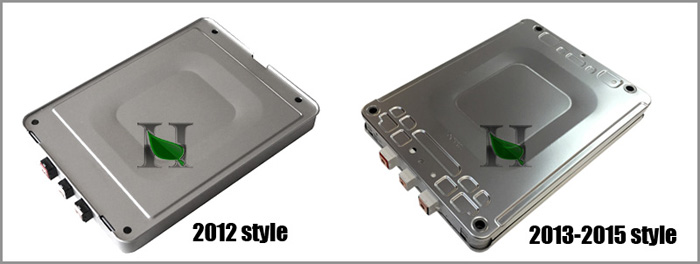
When a battery pack for a custom project is being calculated, every module should be considered as two batteries 3.8V / 60Ah each, already connected in series. As a result each module is 7.6V average, max 8.4V. For instance, to make 45V battery - 6 modules can be used.
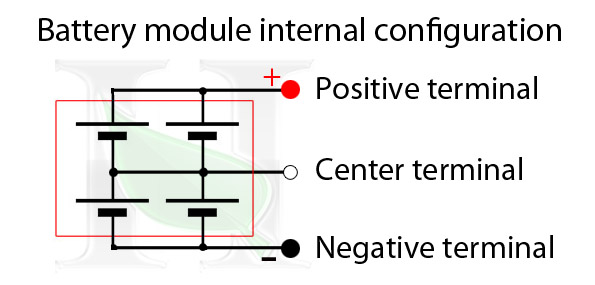
MODULE SPECIFICATIONS
| 4 cells in module | |
| Construction | 2 in-series pairs in parallel |
| Length | 11.9291" (303 mm) |
| Width | 8.7795" (223 mm) |
| Thickness | 1.3779" (35 mm) |
| Weight | 8.3775 lbs (3.8 kgs) |
| Output terminal | M6 nut |
| Voltage sensing terminal | M4 nut |
| Module fixing hole diameter | 0.3582" (9.1 mm) |
CELL SPECIFICATIONS
| Cell type | Laminate type |
| Cathode material | LiMn2O4 with LiNiO2 |
| Anode material | Graphite |
| Rated capacity (0.3C) | 33.1 Ah |
| Average voltage | 3.8 V |
| Length | 11.417" (290 mm) |
| Width | 8.504" (216 mm) |
| Thickness | 0.2795" (7.1mm) |
| Weight | 1.7624 lbs (799 g) |
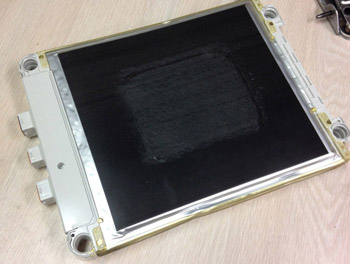
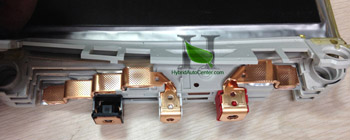
Charging
Every cell should not go over 4.2V during the charging in any case. The battery should be charged CCCV to 4.2V. In many cases it is recommended limiting the charging to 4.1 - 4.15V, (especially if not using BMS).
The charging current should not go over 120A. High current charging shortens the battery life. Nissan also does not recommend for everyday use. The normal charging is 15-20A - 3-4h or 1/3C.
Using a BMS during charging is strongly recommended. It is a must to protect the batteries from overcharging and to do the balancing. An intelligent BMS will protect also from overcharging at low temperatures.
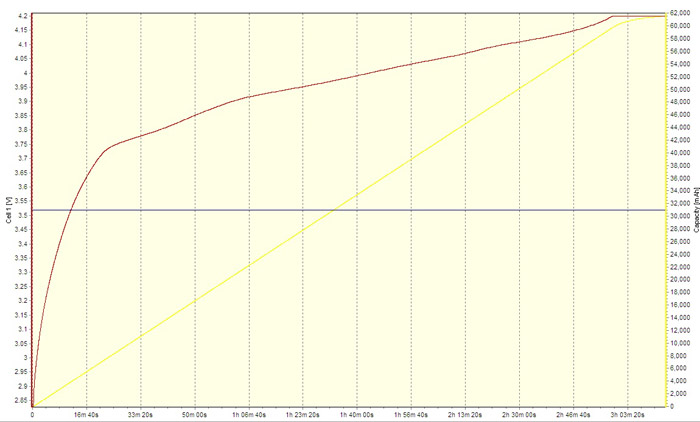
Discharging
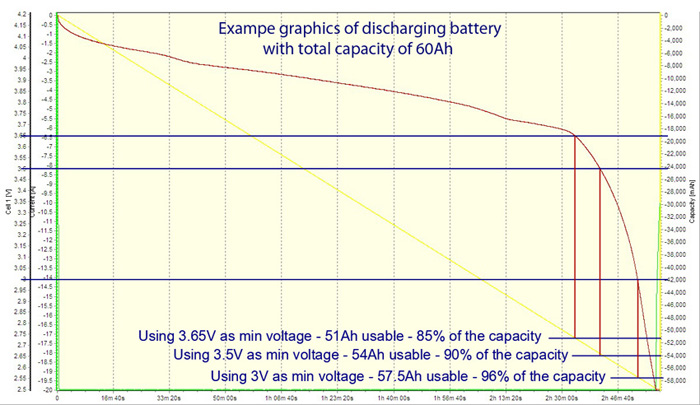
According US Department of ENERGY study* these batteries can provide up to 240A continuous or over 540A short time on pulse (time is not specified).
See the graphics for the level of discharge vs. used capacity.
Most lithium batteries are tested by standard at 1/3C. If measured at 1/7 or 1/10C they could show significantly higher results. And to the opposite, at 1C the capacity will be lower. A 60Ah battery measured at 1/3C (20A) will show 50Ah at 4C (240A tested).
If higher current of discharge or higher capacity is necessary, these batteries could be connected in parallel - see the graphics bellow. Each module contains two cells so for this reason it is illustrated as two separate batteries connected in series.

Temperature requirements
These cells cannot be charged at temperatures under 0C (32F). If this is necessary a battery heater during must be added and used during the charging process.
Storage
These batteries can hold the charge for a long time. Under normal conditions, stored properly they have very low self-discharge. Our experiments showed that a battery module stored for a year lost only 50mV - went from 3.8V to 3.75V. That is equivalent to loosing 10% charge per year. For long term storage is recommended battery to be at 40-50% charge.
Storage at higher temperatures (over 50C) decreases the battery life. The battery could be stored at low temperatures, but should not be charged at temperatures under 0C.
Charging/Discharging cycles
The battery is rated for 1200 cycles at 0-100% charge until it reaches the 80% of the capacity or 5000 cycles when used 0-80% charge.
Click here to see the study.
Disclaimer
This page is for informational purposes only and should not be considered a reliable source of information. The manufacturer does not provide an official information. All presented here parameters are collected from different internet sources or are based on our own observations and should not be considered as instructions on how to use these batteries. Use them at your own risk.
Watch this video to see how likely this battery will catch fire:
- Részletek
- Írta: Molnár Norbert
- Kategória: Akku
- Találatok: 504
- 58Ah (109$)
- 2013 - 2015 62Ah, 2x3.8V, 470Wh (129$)
- 2015 64Ah, 500Wh (139$)
- a
- b
- c
LITHIUM BATTERY MODULE LiMn2O4/LiNiO2
Each module contains two lithium cells - each 3.8V average, total 7.6V
Measured capacity 64Ah
max continuous power 1875W or 240A
Peak current 540A
Made for Nissan LEAF EV CAR
Maximum voltage 4.2V per cell / 8.4V per battery
Average voltage 3.85 V
90% of the capacity voltage - 4.2-3.65V
These battery modules come from a 2015 car.
MODULE SPECIFICATIONS
| Number of cells | 4 |
| Construction | 2 in-series pairs in parallel |
| Length | 11.9291" (303 mm) |
| Width | 8.7795" (223 mm) |
| Thickness | 1.3779" (35 mm) |
| Weight | 8.1571 lbs (3.7 kgs) |
| Output terminal | M6 nut |
| Voltage sensing terminal | M4 nut |
| Module fixing hole diameter | 0.3582" (9.1 mm) |
CELL SPECIFICATIONS
| Cell type | Laminate type |
| Cathode material | LiMn2O4 with LiNiO2 |
| Anode material | Graphite |
| Rated capacity (0.3C) | 33.1 Ah |
| Average voltage | 3.8 V |
| Length | 11.417" (290 mm) |
| Width | 8.504" (216 mm) |
| Thickness | 0.2795" (7.1mm) |
| Weight | 1.7624 lbs (799 g) |
- Részletek
- Írta: Molnár Norbert
- Kategória: Leaf 2
- Találatok: 364
A töltőhálózat érdekes módon Franciaországban a leggyengébb. Legalábbis a mifelénk vezető út mentén...
Az ingyenes oszlopok romantikáját júniusban megismertem már, ezért most a fizetősöket akartam kitapasztalni. Eredetileg 100km-enként akartam tölteni, hogy "biztonsággal és gyorsan" végighajózzunk, de egy Sodetrel (Corridoor) oszlop kiesése ezt gyorsan keresztülhúzta. A B terv inkább B és C terv volt, és volt egy félősnek gondolt 157km benne (ez 2, működő oszlop közti minimum táv...). Aztán amikor az első töltést elég volt 171km után abszolválni, akkor megnyugodtunk, és (D terv mentén) nem volt gond, hogy ritkák az oszlopok, beválasztottunk olyanokat is, amik 150-160 km körüli etapokat adtak ki. Persze azok már nemcsak Sodetrel oszlopok voltak, és ingyenesek is voltak köztük.
Ahol fizetni kellett, ott ChargeMap-ot használtunk, és működött is.
Németeknél is használtunk fizetős oszlopot, NewMotion-nal, mert elvileg olcsób valamivel, mint a PlugSurfing.
Itt baromi egyszerű volt tervezni, mert legnagyobb táv, ami 2 töltőpont-opció közt volt, az 54km volt, de volt egy csomó, amik közt csak 5-20km volt. Ezt azért irigylem tőlük.
Osztrákoknál csakis Smatrics, Haid-nál Ikea alatt és Alland-nál a kút mögött. Ezek pont jó helyen voltak, St.Pölten-i ingyen pontokat nem hajkurásztuk, mert azok pont "félúton" lettek volna.
Természetesen 6.6-os, az ára meg csak akkor derül ki, ha már rajta van a zöld rendszám, és átszámoljuk a túra költségeit is.
Ez jóval többet került, mint az előző Leafem, saját pénztárcából nem is tudtam volna megvenni. De egy jóbarátom, aki már az előző túrát is irigykedve nézte, betársult. Pénzzel is, idővel is, és együtt hoztuk be.
Emiatt persze "meg vannak számlálva a napjai", el kell adni, és most úgy tűnik, hogy 7,5M körüli vételárral mi sem fizetnénk rá.
Egy 6,5 hónapos, ~9.000km-es Tekna-hoz képest ez szerintem elég jó ár. Még az állami támogatás megszerzésével se lehet ennyiért hasonlót venni itthon... (Azt pedig tudjuk, mennyire macera és mennyire nem biztos az állami támogatásos sztori).
De előbb kell rá zöld rendszám, és én is akarom használni egy kicsit... Imádom...
Alighanem 11.000km is lesz benne, mire meghirdetésre kerül :))))))
Hatótáv 244km:
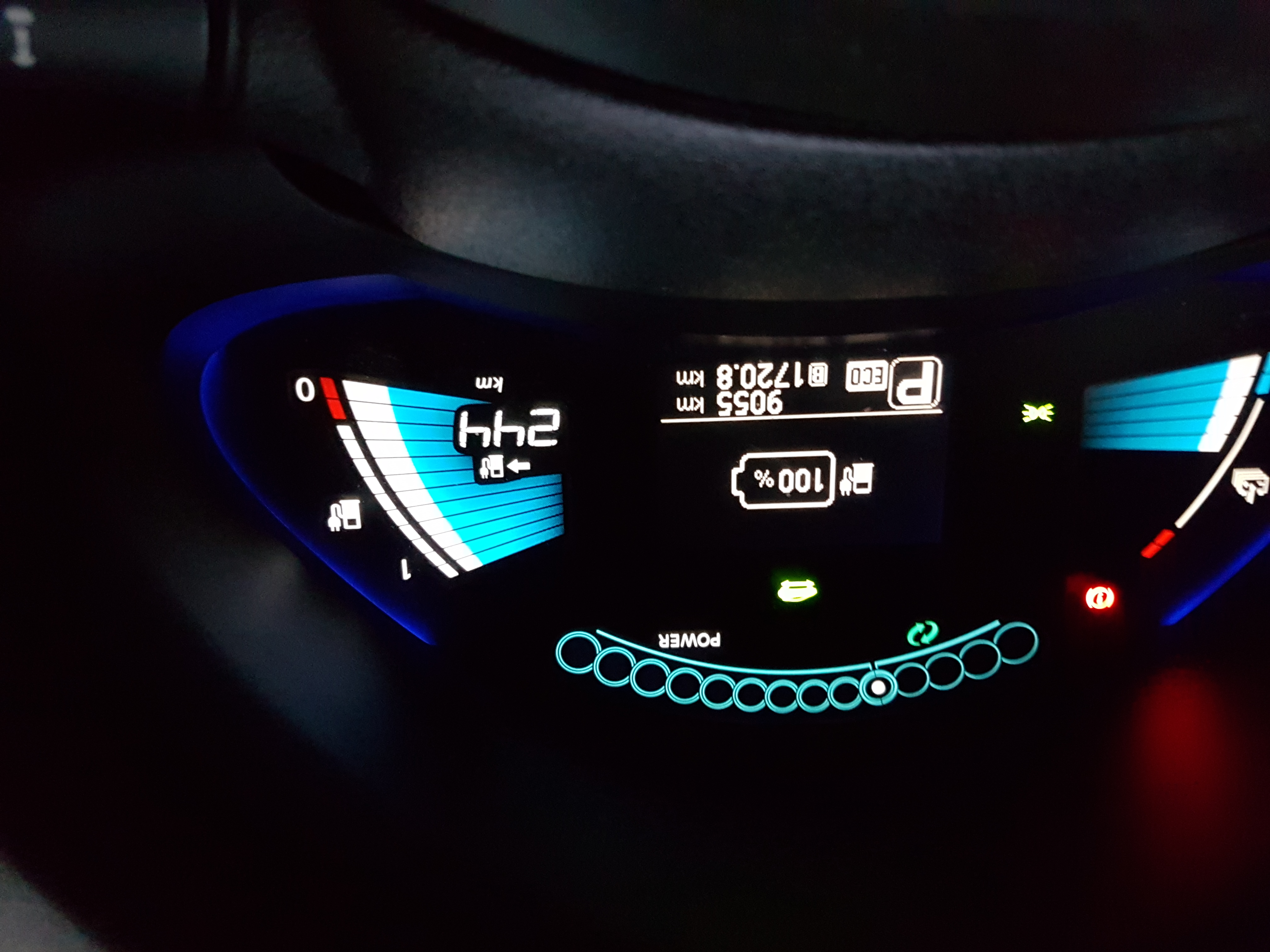
Alkategóriák
Jó tulajdonságok Cikkek száma: 3
Amik nyerők az autóban
Trükkök Cikkek száma: 5
Tippek-trükkök
Zavaró dolgok Cikkek száma: 4
Ami "ki találta ezt ki?"...
Tapasztalat Cikkek száma: 6
Egyéb dolgok a használat közben
LINK-ek Cikkek száma: 13
Linkgyűjtemény, kiemelt mondatokkal...
